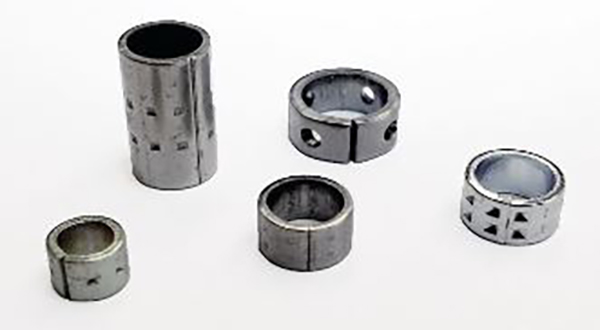Metal Bushings

Metal bushings, also known as torque limiters, are cylindrical components that improve efficiency and minimize noise and vibration in equipment with rotating or sliding shafts. They ensure smooth operation in a range of high-impact, high-load applications, from heavy-duty agricultural equipment to automotive mechanical assemblies. For optimal performance, metal bushings require accurate design specifications, careful material selection, and precision machining or stamping techniques.Metal bushings are designed to maintain component alignment, reduce wear, and minimize friction between two surfaces sliding against one another. They can also be used as guides to maintain accuracy during precision metal drilling applications. Classified as a type of bearing, bushings differ from other bearings by their simplistic design and lack of rolling or ball elements. While bushings are single-part components, they can be constructed with multiple layers of conductive or insulating materials or lubricated depending on the needs of the application.
The main benefits of bushings over other types of bearings include:
Lighter weight
Lower cost
Higher load-carrying capacities
More resistant to shock loads and oscillations
More tolerant of shaft misalignments
While standard bushings are sufficient for most general applications, advanced or specialized applications may require custom-designed bushings made from specific types of material. Selecting the best bushing for a project requires knowledge of the application’s technical requirements and operating conditions as well as an understanding of bushing technology.
Bushing Applications
Bushings can be designed and optimized to fit applications with a range of performance specifications and service environments. Common bushing applications include:
Engines: Durable, heat-resistant bushings are commonly used in internal combustion engines to reduce friction, vibration, and noise while maintaining proper component alignment.
Automotive parts: In automobiles, bushings can be found in everything from shock absorber mountings and control arms to suspension and steering joints. By regulating joint movement, they significantly reduce wear, vibration, and noise. Bushings designed for automotive applications must be made from heat- and corrosion-resistant materials that can withstand repetitive motion.
Food processing equipment: Food processing equipment requires metal bushings made from hygienic, food-grade materials such as stainless steel or thermoplastics. In addition to protecting the equipment’s components, these bushings tolerate heavy-use conditions, high heat, and frequent cleaning.
Industrial machinery: In industrial machinery, precision metal bushings ensure accurate spacing on shafts while minimizing wear between rotating or sliding components. This helps increase the longevity of the equipment and its internal parts.
Household electronic appliances: Bushings are commonly used to absorb shock and vibration in dishwashers, washing machines, and other domestic appliances.
Material handling equipment: In material handling equipment, bushings play an important role in minimizing vibration, reducing noise, and protecting components in pivot joints, attachment joints, rollers, and pulleys.
Construction/mining equipment: Bushings are an essential component of high-load joints, clamping systems, and attachments in construction and mining equipment. These applications generally require durable, corrosion-resistant bushings that can handle heavy loads and abrasive conditions.
Agriculture/forestry equipment: Agriculture and forestry equipment requires durable, corrosion-resistant bushings that can support joints and clamping systems while withstanding impact, abrasion, and harsh outdoor conditions.
Transportation: Durable metal bushings are used in a range of transportation applications, from railroad systems and trolleybuses to heavy trucks and off-road vehicles. These applications depend on resilient, corrosion-resistant bushings that can tolerate high levels of shock and vibration.
Bushing Materials
Metal bushings can be made from a range of cast or machined metals and alloys. The chosen material should be capable of protecting the rotating or sliding components from damage while withstanding the specific conditions of use. Two common metal bushing materials include:
Steel: Steel is a high-strength iron-carbon alloy with a carbon content ranging from 0.002–2.1%. Bushings made from steel offer exceptional fatigue resistance, corrosion resistance, and surface behavior. These attributes make them a long-lasting and reliable solution for high-load, high-impact applications involving extreme temperatures or corrosive conditions. They also guide drill jigs and other machining operations.
Aluminum: Known for its excellent strength-to-weight ratio, aluminum is commonly used to produce lightweight bushings used in light-duty, low-speed applications. Aluminum can also be alloyed with other metals to create bushings with specific material properties for certain applications. For example, aluminum bronze bushings combine the benefits of bronze and aluminum to provide excellent tensile strength, ductility, weldability, and fatigue resistance. They also offer great corrosion resistance, making them ideal for various moisture-rich environments.